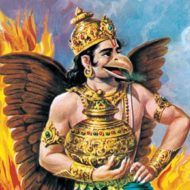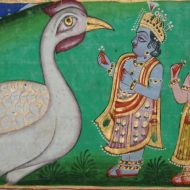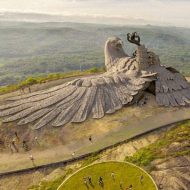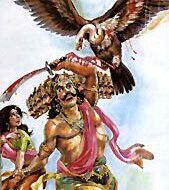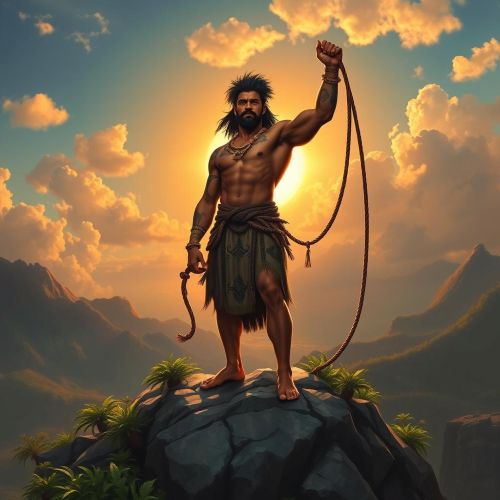Jatayu : The Defender
Listen
At a glance
| Description | |
|---|---|
| Origin | Indian Mythology |
| Classification | Animals |
| Family Members | Aruna (Father), Vinata (Mother), Sampati (Brother) |
| Region | India, Sri Lanka |
| Associated With | Protection, Information of Sita |
Jatayu
Introduction
Within the Hindu Epic Ramayana, we encounter the mention of a celestial avian entity known as Jatayu. While various narratives and legends surround the origin and existence of Jatayu, his notable appearance within the Epic occurs as he valiantly endeavors to rescue Goddess Sita, the beloved spouse of Lord Rama, from the clutches of Ravana, the malevolent ruler of Lanka.
In the Ramayana, when Jatayu witnesses Ravana abducting Goddess Sita, he courageously endeavors to rescue her from the clutches of Ravana. Jatayu engages in a fierce battle with Ravana, displaying remarkable valor. However, owing to Jatayu’s advanced age, Ravana soon gains the upper hand.
As fate would have it, Lord Rama and Lakshmana happen upon the grievously wounded Jatayu in their relentless search for Sita. Jatayu, on the brink of life, informs them that Sita had been taken southward. Sensing Jatayu’s impending departure, Lord Rama drives an arrow into the ground, summoning the seven sacred rivers, known as Teertha, to grant Jatayu Moksha, or liberation from the cycle of life and death.
Physical Traits
These beings possessed a vulture-like form and were considered demigods. They were granted a divine blessing that allowed them to adjust the size of their wings according to their requirements.
Family
Jatayu, a celestial bird, hailed from the illustrious lineage of eagles known as the Garudas. Born to the esteemed sage Aruna, who served as the charioteer of the Sun God, Surya, and his wife, Vinata, Jatayu shared his lineage with a younger sibling named Sampati. Both brothers were bestowed with extraordinary power, formidable strength, and the remarkable ability to traverse vast distances through flight. Their destinies were intertwined with the unfolding of momentous events in the realm of mythology, shaping the very fabric of the world.
In their youth, Jatayu and Sampati were inseparable, their days filled with exploration of the boundless skies, soaring to ever-greater heights. On one fateful day, their celestial journey led them closer and closer to the sun. Despite the relentless heat and blinding brilliance, driven by their inexhaustible curiosity and youthful spirit, they continued their ascent.
Recognizing the perilous nature of their endeavor, Sampati selflessly took it upon himself to shield Jatayu from the searing intensity of the sun’s rays. He unfurled his wings wide, providing a protective barrier for his brother. Regrettably, in his noble act, Sampati’s wings bore the brunt of the sun’s scorching power, and he descended to the earth, forever deprived of his ability to take flight. Witnessing his brother’s sacrificial act, Jatayu was overwhelmed with a profound sense of gratitude and sorrow. From that moment onward, Jatayu vowed to be a guardian and protector to those in need.
As time passed, Jatayu matured in both strength and wisdom, earning a reputation as a formidable and virtuous being. During this period, he crossed paths with the legendary King Dasharatha, the father of Lord Rama, one of the most revered incarnations of Lord Vishnu. A deep bond formed between Jatayu and Dasharatha, and the majestic bird solemnly pledged his loyalty to the king, promising to be his unwavering ally and guardian.
Powers and Abilities
During Rama’s exile in the forest, when Ravana attempted to abduct Sita from Rama, it was Jatayu who valiantly engaged Ravana in a prolonged battle. Remarkably, Jatayu managed to dislodge Ravana from his chariot while they both soared through the skies. However, Ravana, undeterred, brandished his colossal sword and severed both of Jatayu’s wings.
Subsequently, Jatayu patiently awaited Rama’s arrival in his quest to find Sita. When Rama and Lakshmana finally came searching, Jatayu conveyed the distressing news that Sita had been abducted by Ravana and flown in the southward direction. With his last breath, Jatayu passed on this crucial information, becoming the first to reveal Sita’s whereabouts following her kidnapping.
Rama, in turn, enlisted the help of Hanuman and dispatched him to the south in pursuit of Sita. However, despite their efforts, Hanuman and the group of monkeys accompanying him could not initially locate Sita. Exhausted and disheartened, they encountered Sampati, who, unable to fly, regarded these monkeys as potential prey. Yet, Sampati overheard the monkeys discussing Jatayu, Rama, and Sita, realizing their noble intentions. Consequently, he shared with them the direction in which Ravana had flown with his chariot and provided information about the distance to his island, which would later become known as Sri Lanka.
Modern Day Influence
The colossal sculpture christened “Jatayu” stands proudly within the Jatayu Earth’s Center Nature Park, nestled in Chadayamangalam, Kerala. This monumental artwork, credited as the world’s largest bird sculpture, spans an impressive 61 meters in length, 46 meters in height, and 21 meters in width. It was masterminded and brought to life by filmmaker and sculptor Rajiv Anchal, a heartfelt homage to Jatayu’s unwavering bravery and selflessness. This awe-inspiring sculpture also hosts a museum and an adventurous park within its grandeur.
Jatayu’s character continues to find its place in contemporary literature, often influenced by or rooted in the timeless epic of the Ramayana. For instance, in Amish Tripathi’s “Scion of Ikshvaku,” Jatayu takes on the role of a Naga warrior, aiding Rama and Sita in escaping a forest fire. Ashok Banker’s “Prince of Ayodhya” envisions Jatayu as a winged humanoid, leading the Vidyadhara tribe. In Devdutt Pattanaik’s “Sita: An Illustrated Retelling of the Ramayana,” Jatayu assumes the form of a vulture-like creature, the offspring of Aruna, the charioteer of the sun god, captivating readers with his unique portrayal.
Related Images
Frequently Asked Questions
What is lorem Ipsum?
I am text block. Click edit button to change this text. Lorem ipsum dolor sit amet, consectetur adipiscing elit. Ut elit tellus, luctus nec ullamcorper mattis, pulvinar dapibus leo.
What is lorem Ipsum?
I am text block. Click edit button to change this text. Lorem ipsum dolor sit amet, consectetur adipiscing elit. Ut elit tellus, luctus nec ullamcorper mattis, pulvinar dapibus leo.
What is lorem Ipsum?
I am text block. Click edit button to change this text. Lorem ipsum dolor sit amet, consectetur adipiscing elit. Ut elit tellus, luctus nec ullamcorper mattis, pulvinar dapibus leo.
What is lorem Ipsum?
I am text block. Click edit button to change this text. Lorem ipsum dolor sit amet, consectetur adipiscing elit. Ut elit tellus, luctus nec ullamcorper mattis, pulvinar dapibus leo.
What is lorem Ipsum?
I am text block. Click edit button to change this text. Lorem ipsum dolor sit amet, consectetur adipiscing elit. Ut elit tellus, luctus nec ullamcorper mattis, pulvinar dapibus leo.

